

Jupiter is now moving south and is nearing the ecliptic so it is becoming less easily imaged from the northern hemisphere. However Jupiter has not reached its solstice so the shadow transits are still moving north. The most remote satellite, Callisto, casts its shadow further north than the inner satellites, and at the end of December 2015, I had what was likely to be my last opportunity to image a shadow transit of Callisto until 2020. (I list this under 2016 because Jupiter gets to opposition in 2016.)
The transit began at about 03:15 in the morning of 25th December 2015. The skies cleared only just in time for the beginning of the transit, and conditions were not good. The shadow transit ended at about 06:45 but the transit of Callisto itself was not due to start until 15:15 in the afternoon, so I was unable to see that (Jupiter had set and I was expected to be elsewhere).
Below are 12 images to show the progress of the transit. All pictures were taken from .avi files made by a DFK21AF04 camera attached to my LX200. The first two pictures and the last six were taken at prime focus, the others using my ×2 SLR lens and reduced back to match the others. All .avi files were processed in RegiStax5 and imported into RegiStax6 for wavelet processing.
The seeing varied a lot during the period (notice the variation in exposure time), so I have processed each file to try to get the best rendition of the planet. Hence its rather different appearance in the pictures. The great red spot is clearly visible in the first five pictures but the Jupiter's rotation has taken it out of view thereafter. Finally around 05:15 the sky was lightening and the seeing deteriorated further so I gave up. Because of the variability and the fact that the pictures were not taken at regular intervals, I have not attempted to turn them into an animation as I did in 2003 when the shadow passed across the equator.
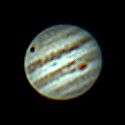 |
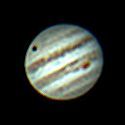 |
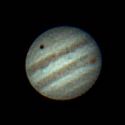 |
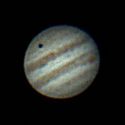 |
| Time: 04:01 Exposure: 1/60 sec Frames stacked: 400 Wavelets: Gaussian Scheme 10 |
Time: 04:08 Exposure: 1/77 sec Frames stacked: 290 Wavelets: 1-4=10 |
Time: 04:40 Exposure: 1/60 sec Frames stacked: 184 Wavelets: Gaussian Scheme 10 |
Time: 04:42 Exposure: 1/45 sec Frames stacked: 184 Wavelets: 1-4=10 |
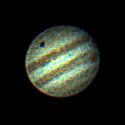 |
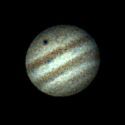 |
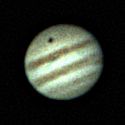 |
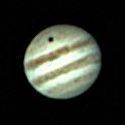 |
| Time: 04:44 Exposure: 1/45 sec Frames stacked: 121 Wavelets: 1-4=10 |
Time: 04:58 Exposure: 1/19 sec Frames stacked: 117 Wavelets: 1-4=10 |
Time: 05:08 Exposure: 1/23 sec Frames stacked: 145 Wavelets: Gaussian Scheme 10 |
Time: 05:13 Exposure: 1/19 sec Frames stacked: 126 Wavelets: Gaussian Scheme 8 |
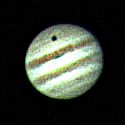 |
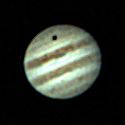 |
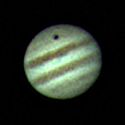 |
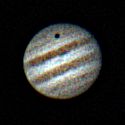 |
| Time: 05:20 Exposure: 1/38 sec Frames stacked: 250 Wavelets: Gaussian Scheme 10 |
Time: 05:27 Exposure: 1/45 sec Frames stacked: 115 Wavelets: Gaussian Scheme 8 |
Time: 05:33 Exposure: 1/60 sec Frames stacked: 126 Wavelets: Gaussian Scheme 8 |
Time: 05:37 Exposure: 1/77 sec Frames stacked: 178 Wavelets: Gaussian Scheme 10 |
Finally here are the full-frame versions of the first and last pictures above, which show the Galilean satellites. I have increased the gamma for these pictures to make the satellites more visible. Move your mouse over the images to see them identified. You can see how much they have moved in the 1 hour and 36 minutes between the pictures.
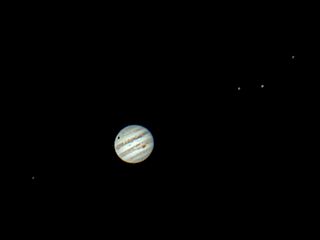 |
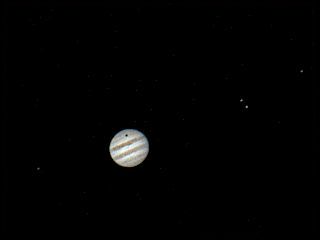 |